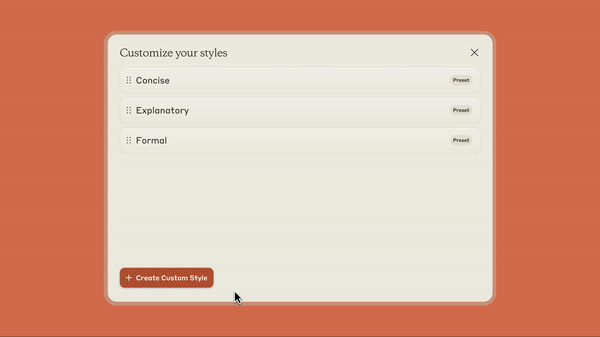Anthropic is rolling out new ways for you to change how your Claude AI chatbot communicates with a new range of pre-set and custom writing styles. Instead of explaining in every prompt how you want the AI to respond, you’ll be able to tailor its conversation to your needs. That means Claude will be as formal or casual, verbose or concise as you wish. It’s a major step to making talking to an AI feel more natural and more like talking to a person, in this case, a person who speaks in a way you prefer.
There are three preset options you can pick from right away. The names are pretty much on the nose. Formal style is for professional, precise responses; Concise is for shorter and direct answers; and Explanatory style is more about explaining and teaching, with extra context and details.
However, the new custom style option is the real eye-catcher. You can create your own personal communication styles for Claude to mimic by uploading samples in the tone and style you want, along with your own words describing the way you want Claude to write. Over time, you can fine-tune and improve the descriptions to make the AI chatbot a perfect mimic. You can see how it works below.

AI at home
“Whether you’re a developer writing technical documentation, a marketer crafting specific brand guidelines, or a product team planning extensive project requirements, Claude can adapt to your preferred way of writing,” Anthropic explained in a blog post. “With styles, Claude adapts to your unique context and communication choices, helping you achieve more while working in a way that feels natural to you.”
For those keen on consistent style, like in business or professional communications, the new feature has obvious appeal. Anthropic pointed to customers like GitHub, which is using the style options to improve internal operations and create marketing copy. It’s worth raising questions about how customizable AI might reshape communication in professional and creative spaces. Could this blur the line between human-authored and AI-generated content? And in scenarios where tone and voice are crucial—like legal documents or sensitive communications—how much responsibility should fall on the AI versus the user to ensure accuracy and appropriateness?
Anthropic’s approach is somewhat unique, but customizing AI responses isn’t entirely new. ChatGPT, Google Gemini, and Microsoft Copilot all have features for customizing tone and voice. Still, Anthropic’s option to infer your preferred style from uploaded content could make it a lot easier to teach the AI how you want it to write.
You might also like
Services Marketplace – Listings, Bookings & Reviews
